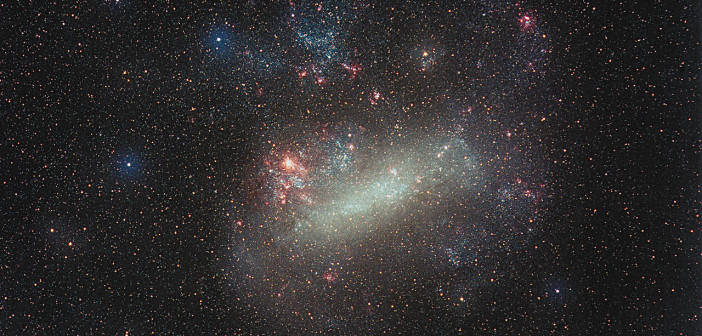The Large Magellanic Cloud (LMC) — a dwarf galaxy that’s a satellite of the Milky Way — may have a newly discovered satellite of its own: a faint collection of stars dubbed SMASH 1. This tiny satellite has a tenuous future, however, as SMASH 1 may soon be torn apart by the LMC’s gravitational forces.
The Search for Faint Neighbors
The difficulty of detecting faint objects means that many low-luminosity satellites have been hiding, unseen, in the fringes of our galaxy. Studying these satellites can reveal information about our galaxy’s history, teaching us about the formation and evolution of galaxies like our own. But to study these faint satellites, we first have to find them!

The position of SMASH 1 relative to other clusters that have been found around the LMC and the SMC. [Adapted from Martin et al. 2016]
In a recent study led by Nicolas Martin (University of Strasbourg and Max Planck Institute for Astronomy), a team of scientists present the discovery of a very faint stellar system, dubbed SMASH 1, that might be a satellite of the Large Magellanic Cloud.
Disrupting System
The team’s analysis of the observations show that SMASH 1 is compact, with a radius of just ~30 light-years (tiny compared to the Milky Way at 50,000 light-years or the LMC at 14,000 light-years in radius!). Its compact size — and the fact that it appears to be an old (13 Gyr) and metal-poor (Z=10-4) star system — cause the Martin and collaborators to argue that this is probably a globular cluster rather than a dwarf galaxy.

The distribution of Milky Way satellites in the size–luminosity plane. Globular clusters are shown as squares, Milky Way dwarf galaxies as circled dots, DECam-enabled discoveries as large dots, and SMASH 1 as a yellow star. [Martin et al. 2016]
The discovery of SMASH 1 raises some interesting questions, such as how it has presumably survived many orbits without disrupting before now. To better understand this satellite, the next step is to obtain follow-up velocity measurements. These will allow us to determine whether its orbit truly is bound to the LMC, or if SMASH 1 is a satellite of the Milky Way instead.
Citation
Nicolas F. Martin et al 2016 ApJ 830 L10. doi:10.3847/2041-8205/830/1/L10

3 Comments
Pingback: LMC disrupts a satellite of the LMC
Pingback: SMASH 1: satellite dal futuro segnato? | Accademia delle Stelle
Pingback: Mogelijk satelliet van de Grote Magelhaanse Wolk ontdekt